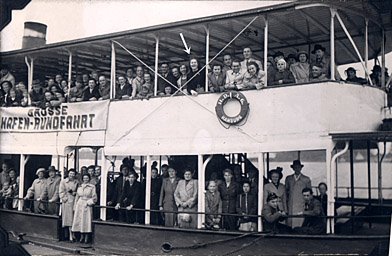DON'T KNOW WHAT TO DO.
I’m a bit weirded out right now. It’s got to do with old family friends.
My parents immigrated to Canada from Germany in 1951 (mom was 17, pop was 18). They met on the boat—a converted WWII “Liberty” ship, a real deathtrap—later got married, yada yada. My sister Annie was born in ’54. I followed in ’55. (Read about my family's history here.)
The Canada years—we made the move to the U.S.A. in 1960—were pretty wild, in part because of all the new immigrants scratching for jobs, trying to make a go of it, dealing with each other and with the Canadians. My folks made lots of friends, many of them Germans like themselves: young, ambitious, full of dreams.
Helmut and Brigitte Schmidt (not their real names) were among these friends.  Eventually, they, too, moved to the States, and, by the mid-60s, the Bauers and the Schmidts would get together like families do.
I liked Helmut and Brigitte, but I didn’t much like the Schmidt boys. They were coarse, noisy. I always figured that you shouldn't have to be with people that you don't like. I was glad when my family lost contact with this crowd in the early 70s.
Twenty-five or so years later, pop and Helmut ran into each other down near Leisure World, and, well, yada yada.
My folks and the Schmidts seemed to grow close again, and all was well, I suppose. (I wasn’t around for much of this. I saw Helmut and Brigitte maybe a couple of times.) Then, maybe six months ago, Brigitte suffered a stroke, and she was pretty bad off. Helmut, who is very healthy (he's into the Senior Olympics), wouldn’t leave her side. He seemed utterly devoted to her.
Eventually, they, too, moved to the States, and, by the mid-60s, the Bauers and the Schmidts would get together like families do.
I liked Helmut and Brigitte, but I didn’t much like the Schmidt boys. They were coarse, noisy. I always figured that you shouldn't have to be with people that you don't like. I was glad when my family lost contact with this crowd in the early 70s.
Twenty-five or so years later, pop and Helmut ran into each other down near Leisure World, and, well, yada yada.
My folks and the Schmidts seemed to grow close again, and all was well, I suppose. (I wasn’t around for much of this. I saw Helmut and Brigitte maybe a couple of times.) Then, maybe six months ago, Brigitte suffered a stroke, and she was pretty bad off. Helmut, who is very healthy (he's into the Senior Olympics), wouldn’t leave her side. He seemed utterly devoted to her.
 Eventually, they, too, moved to the States, and, by the mid-60s, the Bauers and the Schmidts would get together like families do.
I liked Helmut and Brigitte, but I didn’t much like the Schmidt boys. They were coarse, noisy. I always figured that you shouldn't have to be with people that you don't like. I was glad when my family lost contact with this crowd in the early 70s.
Twenty-five or so years later, pop and Helmut ran into each other down near Leisure World, and, well, yada yada.
My folks and the Schmidts seemed to grow close again, and all was well, I suppose. (I wasn’t around for much of this. I saw Helmut and Brigitte maybe a couple of times.) Then, maybe six months ago, Brigitte suffered a stroke, and she was pretty bad off. Helmut, who is very healthy (he's into the Senior Olympics), wouldn’t leave her side. He seemed utterly devoted to her.
Eventually, they, too, moved to the States, and, by the mid-60s, the Bauers and the Schmidts would get together like families do.
I liked Helmut and Brigitte, but I didn’t much like the Schmidt boys. They were coarse, noisy. I always figured that you shouldn't have to be with people that you don't like. I was glad when my family lost contact with this crowd in the early 70s.
Twenty-five or so years later, pop and Helmut ran into each other down near Leisure World, and, well, yada yada.
My folks and the Schmidts seemed to grow close again, and all was well, I suppose. (I wasn’t around for much of this. I saw Helmut and Brigitte maybe a couple of times.) Then, maybe six months ago, Brigitte suffered a stroke, and she was pretty bad off. Helmut, who is very healthy (he's into the Senior Olympics), wouldn’t leave her side. He seemed utterly devoted to her. It was touching. So said my folks.
Recently, Brigitte was allowed to return to their place in Leisure World. But she wasn’t getting better. She was a little crazy and difficult. Helmut was determined to take care of her, but it was getting harder. He evidently felt that he was not up to the task.
He showed signs of depression, we heard. My dad made some efforts to contact Helmut last week, but Helmut wasn’t answering his phone.
Strange.
Last week, in his apartment, he shot his wife dead and then he shot himself. The bodies were discovered on Friday.
Helmut and Brigitte were nice, ordinary people. People liked them; they had lots of friends. This thing caught everybody by surprise.
Especially my parents.
What does it all mean? My parents sit and think. They run around, trying to do things. But they don’t know what to do.
Nobody does.





